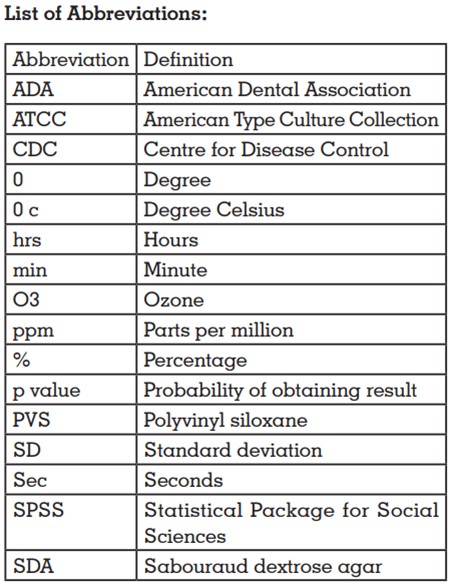

Aims: To compare the efficacy of ozone water and
2% glutaraldehyde in disinfecting polyvinyl siloxane
impression and the effect of both disinfectants on
the wettability, dimensional accuracy and surface
detail reproduction of the material.
Settings and Design: In vitro – comparative study
Material and Methods: Samples (N =108)
were subjected to disinfection either with 2%
glutaraldehyde (group 1) or ozone water (group 2)
for 15 minutes. To evaluate the efficacy, the samples
were inoculated with Streptococcus mutans [ATCC
25175], Staphylococcus aureus [ATCC 25923] and
Candida albicans [ATCC 10231]. Reductions in the
number of microbial population after disinfection
were determined by counting the colony forming
units (CFU). The contact angle measurements on
the impression surface were used to determine the
wettability. Dimensional accuracy and surface detail
reproductions of the samples were assessed with a stereomicroscope of 4X magnification.
Statistical analysis used: paired t- test and chi-square test were used.
Results: The efficacy of both disinfectants in reducing
the microbial count found to be comparable.
Both the disinfectants reduced the contact angle
which improved the wettability of the material.
Disinfection with 2% glutaraldehyde showed
significant alteration in dimensional accuracy and
surface detail reproduction (p<0.05) when compared
to samples disinfected with ozone water, which
preserves the dimensional accuracy and surface
details.
Conclusions: Ozone water treatment was identified
as a potential method for the disinfection of polyvinyl
siloxane impression as it increased the wettability
of the material, showed least dimensional changes
and preserved surface details more accurately.
Key words: Disinfection, ozone, infection control, polyvinyl siloxane impression.
Prosthodontics is one field of dentistry where
prevention of cross contamination seems to be
a serious dilemma. The increased awareness of
the dangers of cross contamination with infectious
disease such as Hepatitis B, Hepatitis C, Herpes,
Human immunodeficiency virus disease (HIV),
Tuberculosis and recently Corona virus disease
(COVID- 19) during dental procedures is creating
a growing impact on attitude towards infection
control in dental clinics and dental laboratories.
So infection control is one of the primary facets
of dental care. The increased incidence of
infectious and/or contagious diseases of various
etiologies has forced dental professionals to
adopt precautions for the control of the spread
of microorganisms for the protection of both the
dentists and the patients. Every patient who seeks
treatment should be considered a potential carrier
of an infectious and/or contagious disease1.
Therefore, daily routine measures for the control
of microorganisms should be followed rigorously
in dental practice.
Dental impressions are considered potentially
infectious medium as they are contaminated with
patient’s saliva and blood. Pathogens, if present in
high enough number, can survive several days on
impressions and then can be transferred onto set
gypsum material. Impression disinfection is now
considered a routine procedure in dental offices
and laboratories1, 2. Disinfection of the impression
immediately after removal from the oral cavity is
recommended by American Dental Association
and Centers for disease control and prevention to
avoid possible transmission of infectious diseases2
.
Prosthodontics treatment procedures begin with the
making of dental impression, which forms the first
link in the microbial contamination during dental
care. Poly vinyl siloxane impression material is
one of the most favoured impression materials
in dentistry because of their excellent physical properties, favourable handling characteristics
and good patient acceptance3
. Many disinfectant
agents are used to disinfect dental impression
which may alter the physical properties of the
impression material.
The action of environment friendly ozone as an
oxidizing agent is well known and is being used in a
wide range of applications as a disinfecting agent4
,
killing both gram positive and gram negative
organisms. The disinfection activity of ozone is
due to its ability to attack the cell membrane and
intracellular enzymes of microorganisms, as well
as the viral capsids and DNA.
The purpose of this in vitro study is to compare the
efficacy of ozone water and 2% glutaraldehyde
in disinfecting polyvinyl siloxane impression and
the effect of both disinfectants on the physical
properties of the material such as wettability,
dimensional accuracy and surface detail
reproduction.
The study was approved by institutional ethical
committee, ref no. AEC/REV/2018/26.
The poly vinyl siloxane (PVS) impression material
(AQUASIL, DENTSPLY) medium body consistency
were used in this study. The samples were prepared
using the standardized stainless steel die, as
described in ADA specification no 19 (FIG 1),
scored with three horizontal parallel lines X, Y, Z (
25,50,75 µm wide and 25mm length respectively)
spaced 2.5 mm apart were inscribed between two
vertical lines D1 and D2. Die was ultrasonically
cleaned and air dried to ensure that it was free of
any surface contaminants before each impression
was made. Pre-packaged cartridges of PVS
Impression material with an auto mixing gun
were used for impression making. A total of 108
samples were prepared, 54 each for group 1 (2%
glutaraldehyde) and group 2(ozone water) (FIG 2). 2% Glutaraldehyde (CIDEX, Johnson & Johnson
private limited) and ozone water were used as
disinfectants. Ozone water is produced using an
Ozone generator (Dent ozone India) with a high
voltage electrical discharge at a constant flow
rate by the apparatus and was ejected into the
diffuser through the output tube. The concentration
of ozone used was 2 ppm, and it was generated
for 5 minutes from the apparatus for 100 ml water.
The samples were disinfected with the solution
for 15 minutes.
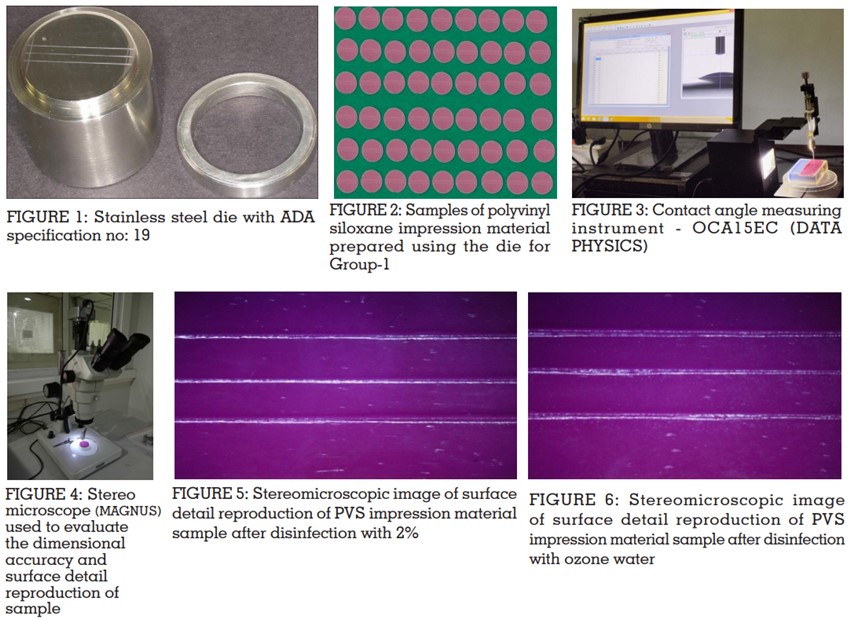
Streptococcus mutans (ATCC 25175),
Staphylococcus aureus (ATCC 25923), Candida
albicans (ATCC 10231) were used for this study.
The strains were supplied by HI media Pvt Ltd. The
inoculating swab which contains Streptococcus
mutans and staphylococcus aureus were seeded
on to blood agar and of Candida albicans were
seeded on to Sabouraud dextrose agar (SDA).
Quadrant streaking was done and the plates
were incubated at 370 c for 24 hours in case of
bacteria and for 48 hrs for Candida albicans. The
microorganisms were harvested after confirming
their presence with the help of a microscope.
S.mutans and S.aureus were then diluted to a
suspension of 105 cfu/ml and C. albicans were
diluted to 107 cfu/ml respectively. Before the
inoculation procedure, the samples were made
sterile by autoclaving in order to avoid other
microbial contamination. 200 ml of the diluted
suspensions of each organism were taken in a
separate glass bottle with tight lid and the samples
were added to the suspension. Then the bottles
were incubated at 370 c for 24 hrs for S. mutans
and S.aureus and 48 hrs for C.albicans. After the
incubation period, samples were removed with
sterile forceps and washed with 15ml of sterile
phosphate buffer solution to remove the non adherent organisms.
Samples (9 each) containing the microorganism
were disinfected with 2% glutaraldehyde and with 2
ppm ozone water respectively for 15 minutes. After
disinfection procedure the samples contaminated
with S.mutans and S.aureus, were transferred to
the sterile BHI broth using a sterile forceps, and
the samples contaminated with C.albicans were
transferred to sterile SDA broth and incubated for
24 hrs and 48 hrs respectively. In order to measure
the viable count of organisms after disinfection,
quadrant streaking was again performed by taking
1 microliter from the broth using a sterile wire loop
and incubated at 37 0 C for 24 hours in case of
bacteria and 48 hrs for fungi. After incubation
period, colonies of microorganisms were observed
and the numbers of colony forming units (cfu)
were calculated.
Wettability was evaluated by measuring the
contact angle on the impression surface. Contact
angles were measured for each sample before
and after disinfection procedure, using contact
angle measuring instrument- OCA 15EC (Data
physics). The samples were placed on the platform
of the testing apparatus, a water droplet (3µl)
dispensed onto the surface of the sample and the
contact angle was measured at 20 seconds. The
mean contact angles were analysed by statistical
methods. (Fig 3)
The length of horizontal line between the cross lines
D1 and D2 were measured using stereomicroscope
(Magnus) of 4x magnification with the help of
image analysis software before and after
disinfection with 2% glutaraldehyde (group 1)
and ozone water (group 2). Dimensional accuracy expressed as percentage dimensional change
(L), was calculated in accordance with ISO 4823
using the equation:
L = (L1-L2)/ L1 × 100
Where, L1 is the length of horizontal line between
D1 and D2 on the samples before disinfection and
L2 is the length of horizontal line after disinfection.
Surface qualities of the samples obtained were
examined using stereomicroscope with 4 x
magnification and rating values were assigned.
Samples were then subjected to disinfection by
immersing in 2% glutaraldehyde solution (group
1) and ozonated water (group 2) for 15 minutes.
After disinfection procedure, the two groups were
again examined.
The results of the present study were analyzed
using the SPSS Version 21 software (Statistical
Package for Social Sciences). The observations
were statistically analyzed. The values were
subjected to student t- test and Chi-square test.
The comparisons were made through the p value
derived from the tests with a significance level of
p<0.05.
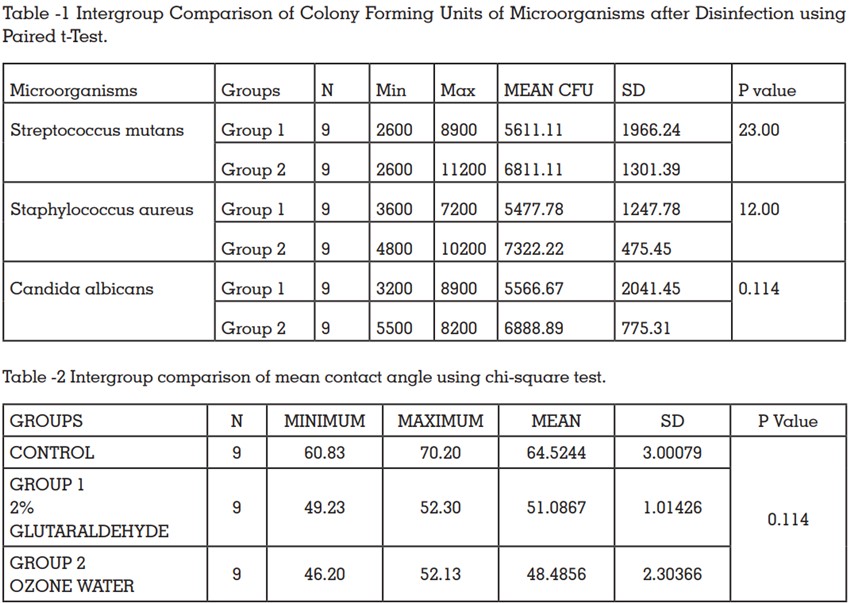
Table (1) and figure (7-12) show the mean CFU
of the studied microorganisms before and after
disinfection with 2% glutaraldehyde and ozonated
water for 15 minutes. Disinfection of the samples
with 2% glutaraldehyde reduced the number of
S.mutans, S.aureus, and C. albicans to 5611.11,
5477.78, and 5566.67 respectively. Disinfection
of the samples with ozonated water reduced the
number of S.mutans, S.aureus, and C. albicans
to 6811.11, 7322.22, and 6888.89 respectively. All
the P>0.05, suggest that there was no statistically significant difference between the groups in
inhibiting the growth of tested microorganisms.
The statistical comparison of resulting contact
angles, presented in Table (2), showed that the
contact angle reduced after disinfection. The mean
contact angle was reduced to 51.080 and 48.480
after disinfection with 2% glutaraldehyde and
ozone water respectively. Both the disinfectants
reduced the contact angle thereby improving the
wettability of the material.
The present study evaluated the dimensional
accuracy in terms of mean percentage dimensional
change before and after disinfection. The result
showed significant dimensional changes in
samples disinfected with 2% glutaraldehyde, p value less than 0.05, whereas samples disinfected
with ozone water showed statistically insignificant
dimensional changes when compared with control
group samples that is samples before disinfection,
p value obtained was 0.133 (>0.05)(Table 3-4)
(Graph 5)
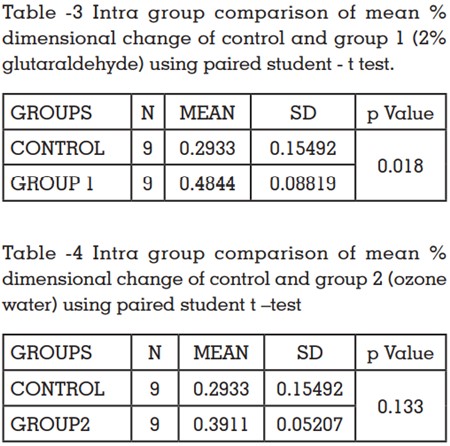
The surface detail reproduction was evaluated in
rate scoring system. Hence, the proportions were
compared using chi-square test, and the p value
was calculated. Table 5–8 shows the intergroup
comparison of surface detail reproduction of PVS
medium body material samples before and after
disinfection. The samples before disinfection and
samples disinfected with ozone water showed more
rating value 1 and rating value 2 in X line (25 µm),
Y line (50 µm), and in Z line (75 µm). Whereas the
samples disinfected with 2% glutaraldehyde (group
1) showed more of rating value 2 and rating 3in
X, Y, and Z lines. (Table 5-8)
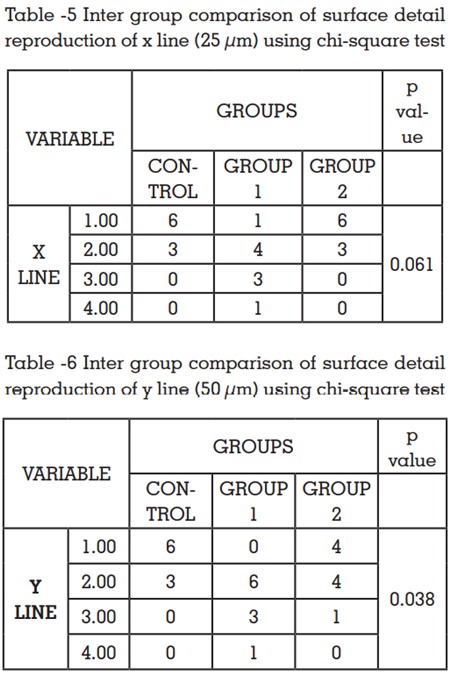
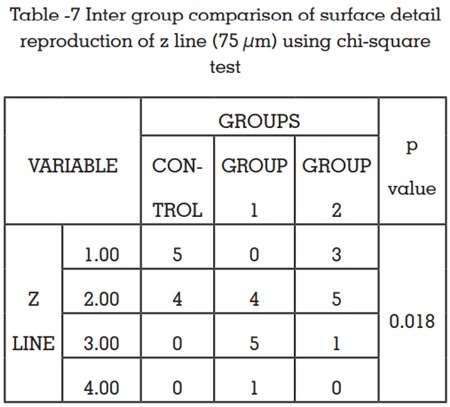
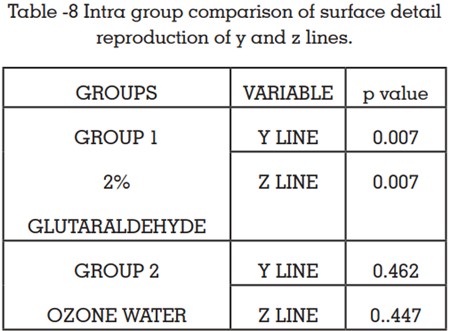
The statistical analysis showed that the significant
value p for samples disinfected with 2%
glutaraldehyde in x line was 0.06, and y line and
in z line was 0.007. The significant p < 0.05 in y
and z lines, hence there were significant change
in surface details in samples disinfected with 2%
glutaraldehyde. Whereas the significant value p
for samples disinfected with ozone water in x line was 0.06, and in y and z line was 0.462 and 0.447
respectively. All the p values were greater than
0.05 (p > 0.05), hence there were insignificant
surface quality changes in samples disinfected
with ozone water. (Graph 6)
Infection control is an indispensable and imperative
concern in the dental practice to prevent the spread
of infections5
. Dental impressions are categorized
under semi critical objects in dental practice and
require high level disinfection5
. American dental
association (ADA) and Centre for disease control
(CDC) suggested disinfection of impressions to
prevent cross infection and this can be accomplished
by either immersion or spraying with disinfectants
or other methods1
.
The disinfecting process is to eliminate the
microorganisms from the surface of the impression
without affecting the quality of the impression. In
the present study, the disinfectant efficacy of ozone
water on the medium body PVS impression samples
was compared with that of 2% glutaraldehyde;
one of the most commonly used disinfectants in
dentistry. Also evaluated and compare their effect
on wettability, Dimensional accuracy and Surface
detail reproduction of the material samples.
The results of the present study confirm those
obtained by Bustos J et al6
and Samra R K et
al7
who reported that impression materials retain bacteria even after disinfection. However,
irreversible hydrocolloid and silicone impressions
can successfully be disinfected with 0.5% NaOCl
solution or 2% glutaraldehyde for 5 minutes.
According to Egusa H e t al8
2% glutaraldehyde
and 1 ppm ozone water can effectively eliminate
the microorganisms from the dental impressions.
Faria I etal9
studied the effects of ozonated water
on Candida albicans oral isolates. He observed
that Ozone is a powerful oxidative agent with
greater bactericidal properties when compared to
chloride. Arita et al10 also stated that application
of ozonated water may be useful in reducing the
number of C. albicans on denture plates. The
results of the present study are in agreement with
these results.
Reduction in CFU of the microorganisms was
noted when the impressions were disinfected
with 2% Glutaraldehyde and Ozone water. For
Streptococcus mutans the mean CFU was reduced
from 105 to 5.61 x 103 when using 2% glutraldehyde
as disinfectant and 6.81 x 103 when ozone water
was used. For Staphylococcus aureus, after
disinfection the mean CFU was reduced from 105
to 5.47 x 103 and 7.28 x 103 respectively for 2%
glutaraldehyde and ozone water. After disinfection
the mean candidal colony was reduced from 107
to 5.57 x 103 and 6.89 x 103 respectively for 2%
glutaraldehyde and ozone water.
There was no statistically significant difference
between 2% glutaraldehyde and ozone water
in eliminating the tested microorganisms. These
results indicate that disinfecting PVS impression
samples with ozone water could lead to reductions
in viable microorganisms comparable to those
achieved with the 2% glutaraldehyde.
The wettability of a surface can be determined by
measuring the magnitude of the contact angle,
which indicates the degree of wetting when the
surface and liquid interact. In the present study,
disinfection with 2% glutaraldehyde reduces the
contact angle of the impression samples, which
was in accordance with the results obtained by the study done by Alzain S, who11 reported that
disinfection with 0.5% glutaraldehyde improved
wettability of polyvinyl siloxane material samples.
Glutaraldehyde acted like a surfactant that
improved wetting potential of the impression
materials16.
Disinfection with ozonated water could render
material more hydrophilic. The mean contact
angle of the control samples was 64.520
, while
the mean contact angle after disinfection with
2% glutaraldehyde was 51.080
and that of ozone
water was 48.480
. The reduction in contact angle
was more in samples disinfected with ozone water.
The results are in agreement with the study done
by Celebi H et al12, who stated that gaseous ozone
treatment was a promising method of disinfecting
PVS impression materials because of its positive
effect on the wettability of the material.
Dimensional accuracy and accurate reproduction
of surface details of the oral structures are inherent
qualities of an impression material. So it is very
important to confirm the dimensional accuracy
and surface quality of the impression even after
disinfection. In the present study disinfection with
2% glutaraldehyde showed significant change in
dimensional accuracy when compared with the
samples before disinfection, p value obtained was
0.018 (p < 0.05).
There is a mean % dimensional change of
0.48 observed in samples disinfected with 2%
glutaraldehyde, whereas samples disinfected with
ozone water showed no significant dimensional
changes when compared with samples before
disinfection, p value obtained was 0.133 (> 0.05).
The results are in agreement with the studies
done by Langenwalter et al13, Melilli D et al14 and
Johnson. G. H et al15. They reported that there were
dimensional changes produced after disinfection
with 2% glutaraldehyde but found to be clinically
in significant.
There is paucity of data in the literature regarding
dimensional stability after disinfection with ozone water. In our study Ozone disinfection
produced minor dimensional change but also
found to be clinically in significant. The mean
percentage dimensional change of PVS medium
body material samples disinfected with ozone
water was 0.39%. The PVS impression material
samples disinfected with ozone water maintain
the dimensional accuracy when compared to the
samples disinfected with 2% glutaraldehyde.
However, the dimensional changes produced by
both 2% Glutaraldehyde and ozone water was
within the standards of ADA specification 19 that
is less than 0.5%13.
Abinaya k et al3
in their study evaluated the
surface quality of silicone impression materials after disinfection with ozone water. The authors
concluded that the ozone water showed
comparatively least changes and well defined lines
when compared to 5.25% sodium hypochlorite,
followed by 2% glutaraldehyde. These findings
are in concur with the results of present study.
The results of the present study showed that the
samples disinfected with ozone water showed
more of rating 1 (well defined sharp detail and
continuous line) and rating 2 (continuous line but
with some loss of sharpness) whereas the samples
disinfected with 2% glutaraldehyde showed more
of rating 2 (continuous line but with some loss of
sharpness) and rating 3 (poor detail or loss of continuity of line) in X, Y, and Z lines respectively.
The statistical analysis showed that the value p for
group 1 and group 2 in X line (25 µm) was 0.061.
The p value for Y and Z lines in samples disinfected
with 2% glutaraldehyde was 0.007 and that of
ozone water was 0.462 and 0.447 respectively.
The results showed there is significant change
in surface detail reproduction of PVS impression
material samples after disinfection with 2%
glutaraldehyde, whereas there is no significant
change in Y and Z lines after disinfection with ozone water.
According to Al Kheraif16 and Abinaya et al14
it has been advised to use ozone water as an
alternative to 5.25% NaOCl, 0.525% NaOCl, and
2% glutaraldehyde for the disinfection of polyvinyl
siloxane impression material. According to Poulis
et al17,18, clinically ozone disinfection is a new
method, which needs no consumables, is time
saving, and requires limited space in the dental
office. This minimizes liquid waste generation
resulting in superior environmental protection. Therefore, ozone is considered as an environment
friendly dental impression disinfection method.
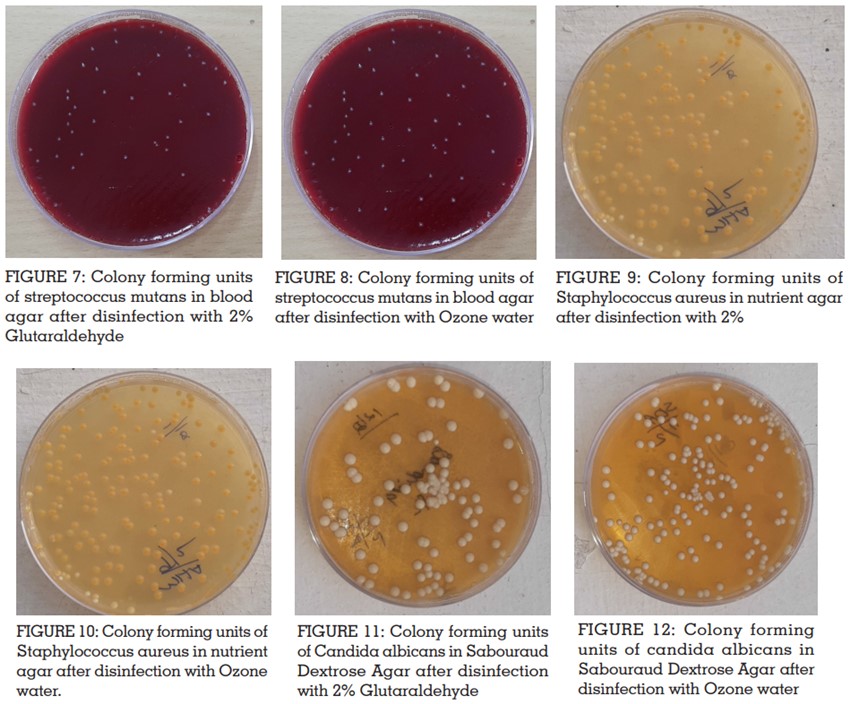
Within the limitations of this study, it can be concluded that
